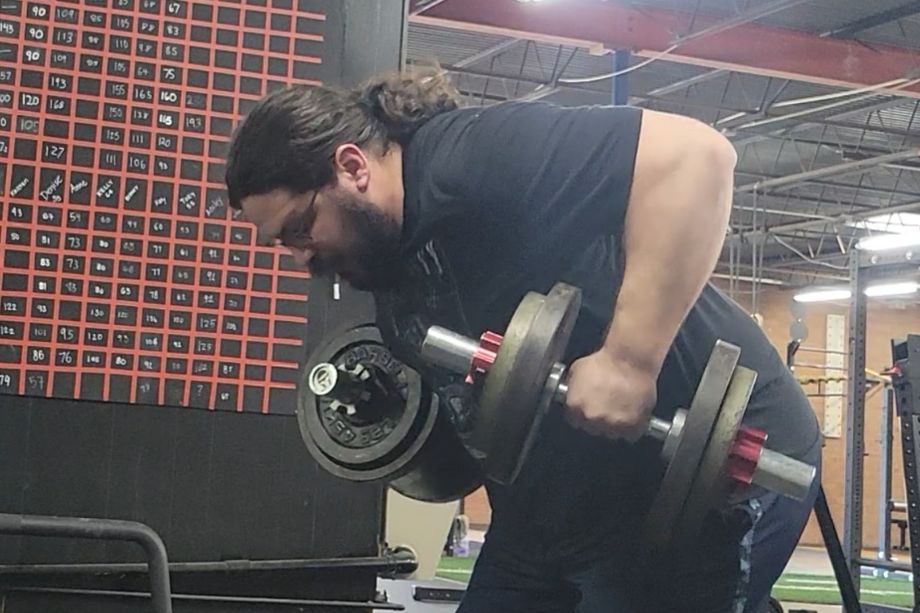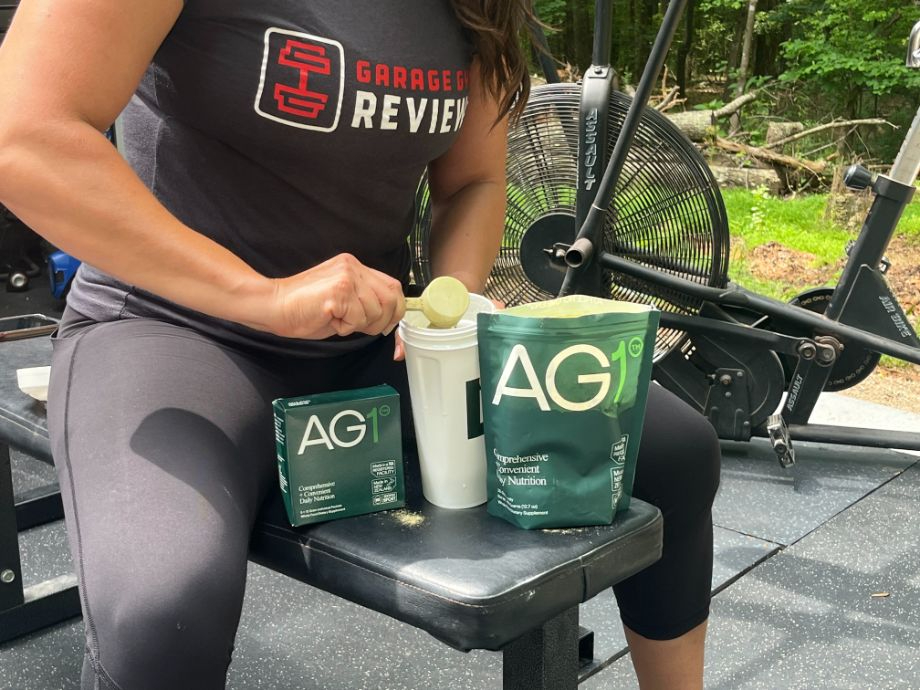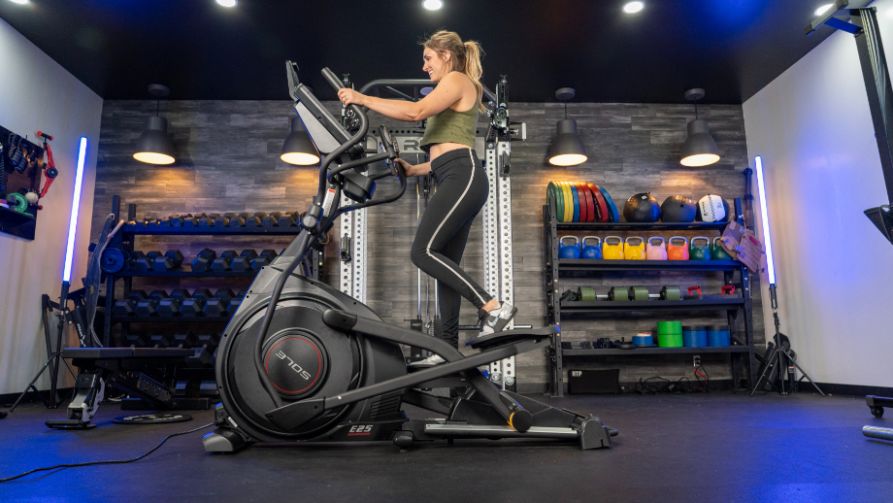The one-arm dumbbell row is more often than not a staple on your back and biceps day, but are there any advantages of grabbing two at a time and row, row, rowing your way gently to some gains?
Performing dumbbell rows bilaterally takes some technique, but there are many benefits beyond simply saving time. Using dumbbells for bent-over rows builds muscle groups throughout your back, making it an indispensable exercise for any and every back workout.
Caine Wilkes, OLY, USAW-L1, and GGR senior staff writer, gives us the low down on the dumbbell row, including how to do them with perfect form, common mistakes to avoid, ways to program the exercise into your workout, and much more!
Back it up, back it in, let us begin!
How To Do Bent-Over Dumbbell Rows
How to do it:
- Stand with your feet shoulder-width apart and hold a dumbbell in each hand with a neutral grip (palms facing each other).
- Lean forward, hinging at your hips, until your torso forms a 45-degree angle with the floor.
- Pull the dumbbells up and into the body until your elbows are at 90 degrees.
- Pinch your shoulder blades together and squeeze your back muscles.
- Slowly guide the dumbbells back to the starting position.
- Repeat for the desired number of repetitions.
RELATED: Best Dumbbells
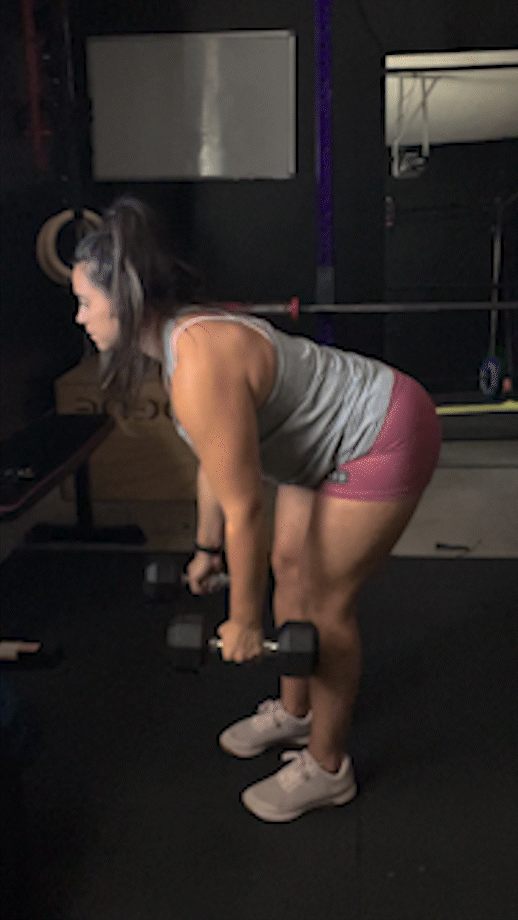
Bent-Over Dumbbell Rows
- Target muscles: Upper back
- Secondary muscles: Arms, shoulders, lower back, core
- Exercise type: Strength
- Movement: Compound
- Level: Beginner
- Equipment needed: Dumbbells
Trainer Tips for Form
Dumbbell rows are considered one of the best back exercises, and you’ll want to perform them with proper form to get the best results. Check out our expert tips right here!
Stay Stable as a Table
Maintaining a rigid posture throughout the row movement is integral for optimizing biomechanics and minimizing your risk of injury.
Here’s a quick breakdown of what that looks like:
- Head and neck: Neutral alignment, chin tucked, eyes facing forward
- Shoulders: Down and back with the shoulder blades pinching at the top
- Back: Neutral spine, no excessive arching and absolutely no rounding
- Core: Tight and engaged
- Lower body: Knees slightly bent, weight between midfoot and heels
According to Sensors (Basel)1, maintaining neutral alignment during lifting exercises like the dumbbell row works wonders to protect sensitive regions like the lower back from sustaining muscle injuries, herniated discs, and more.
Put Your Back Into It
Sure, you’re holding those dumbbells with your hands and moving them using your arms, but the back is the main attraction during the dumbbell row.
“Beginners and casual lifters may not yet have a strong mind-muscle connection,” says Caine Wilkes, OLY, USAW-L1. “That may make conceptualizing and executing a proper dumbbell row using the lats and other back muscles as the prime movers a bit more challenging.”
Studies show2 that a strong mind-muscle connection can help increase muscle activation to the target muscle group, promoting strength and hypertrophy gains. Plus, you’ll have one heckuva time graduating to heavier weights if you’re not properly engaging your back to generate force.
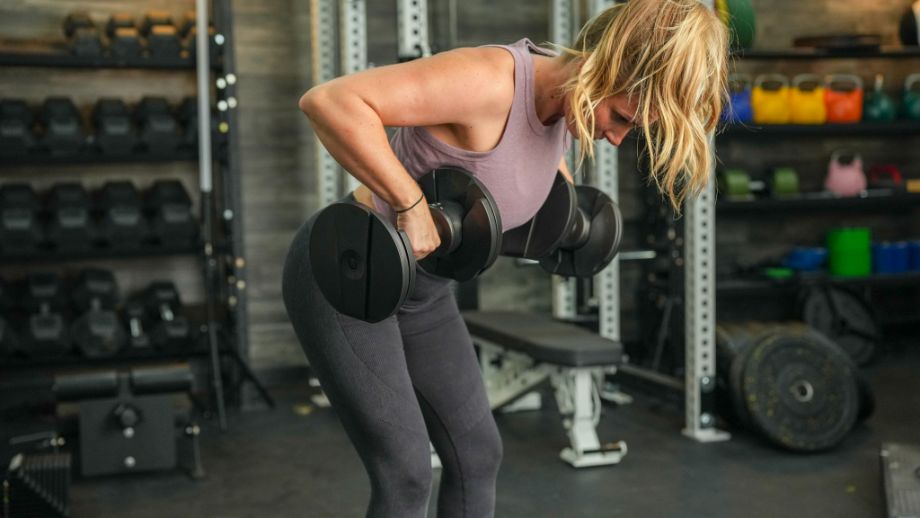
“Lead with the elbows rather than the hands on the pull, maintain scapular retraction throughout the exercise’s full range of motion, and fully control the eccentric phase,” suggests Caine. “I would also recommend going light while learning to get your form dialed in. Going too heavy will only work against you or wind up reinforcing bad habits.”
If you’re still struggling to engage the back efficiently, consider working with a certified personal trainer (CPT), certified strength and conditioning specialist (CSCS), or other qualified fitness professional in order to build a strong mind-muscle connection.
RELATED: Best Weight Benches
Pull to Your Hip
Trainers have devised many cues for helping clients properly engage the back muscles during the dumbbell row and other variations. Pulling the weights back towards your hip is one of the most successful, as it addresses the common mistake of pulling into the rib cage.
“When we focus on pulling the weights high towards our ribs, we wind up with more arm involvement than we’re looking for,” says Caine. “Pulling towards the hip, on the other hand, helps guarantee greater recruitment of the lats, traps, and other back muscles we’re targeting.”
Imagine “scooping” the dumbbell backwards towards your hip as you move. You’ll know you’ve done it right if your elbows wind up in that perfect 90-degree position at the end.
Dumbbell Rows Benefits
The dumbbell row is one of the best dumbbell exercises for your back and biceps workout.
Here are a few reasons why you should add it to your dumbbell workout routine immediately.
Strength and Hypertrophy Gains
Why do we do strength training in the first place? To get bigger and stronger, of course!
“The dumbbell row is a bilateral beast, providing an upper-body workout that can’t be beat,” says Caine. “You get loads of activation in the back, shoulders, and arms, as well as ancillary muscle groups like the glutes, hamstrings, and core muscles.”
In fact, a 2015 study in the International Journal of Sports Medicine3 found that free-weight rows, like dumbbell rows, provided significant muscle activation to your core muscles and posterior chain, including the erector spinae, multifidus, rectus abdominis, and obliques.
That means you can build a bigger, badder back and increase trunk and core stability in one convenient move. That’s what’s up!
Greater Range of Motion
Generally speaking, dumbbells allow a wider range of motion since there’s not a big honking barbell smack dab in the middle. Rowing two dumbbells into the body will, therefore, allow for a greater range of motion versus the tried-and-true barbell row, meaning you’ll be performing more work per rep and saving you time in the long run.
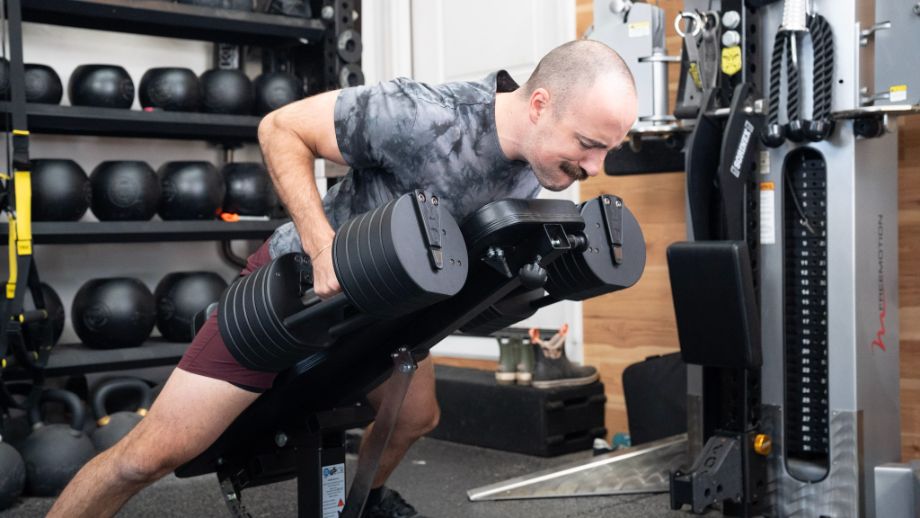
I mean, who doesn’t love great results in comparatively less time?
Addresses Bilateral Deficits
Unilateral training is essential for addressing muscle imbalances and bilateral deficits you may wind up with if you exclusively use barbells or bilateral machines.
“The two-handed dumbbell row technically is a unilateral exercise,” says Caine, “because you can’t rely on your strong side to compensate for weakness on the other side. If you’re struggling to lift the dumbbell in your left hand, nothing your right side can do will help you succeed.”
So, because both sides need to handle their biz’ solo, you’ll wind up with more even muscle growth and strength gains.
Muscles Targeted By Dumbbell Rows
Dumbbell rows are predominantly an upper-body exercise focused on your posterior chain muscles. Here’s a quick breakdown of the muscles you’ll be targeting when you row:
- Trapezius
- Rhomboids
- Latissimus dorsi
- Biceps
- Triceps
- Posterior deltoids
Who Should Do Dumbbell Rows?
We can find a good reason for just about anyone to pick up a pair of dumbbells and smash out a set of dumbbell rows, but some individuals may find this movement more intuitive for their purposes.
- Bodybuilders: You won’t fare well in a bodybuilding competition without a picturesque back. The dumbbell row can help you develop those essential “cobra back” muscles while minimizing stress on your lower back.
- Strength athletes: The dumbbell row is excellent for building strong upper back muscles, which help strongmen and powerlifters move heavier weights in competition.
- Home gym owners: A fully-kitted home gym is a worthy pursuit, but not everyone has the space or money. So, forget about deadlifts and lat pulldowns, which require bulky equipment and specialized machines. For rows, all you need is a pair of dumbbells and you’re golden.
How to Program Dumbbell Rows
Strength training enthusiasts may feel inclined to lead the workout with barbell lifts, but the dumbbell row is just as good at the front of a workout as it is in the middle or even as a closer.
According to the Journal of Strength and Conditioning Research4, performing multi-joint exercises involving large muscle groups first—like the dumbbell row—maximizes your performance and resulting gains.
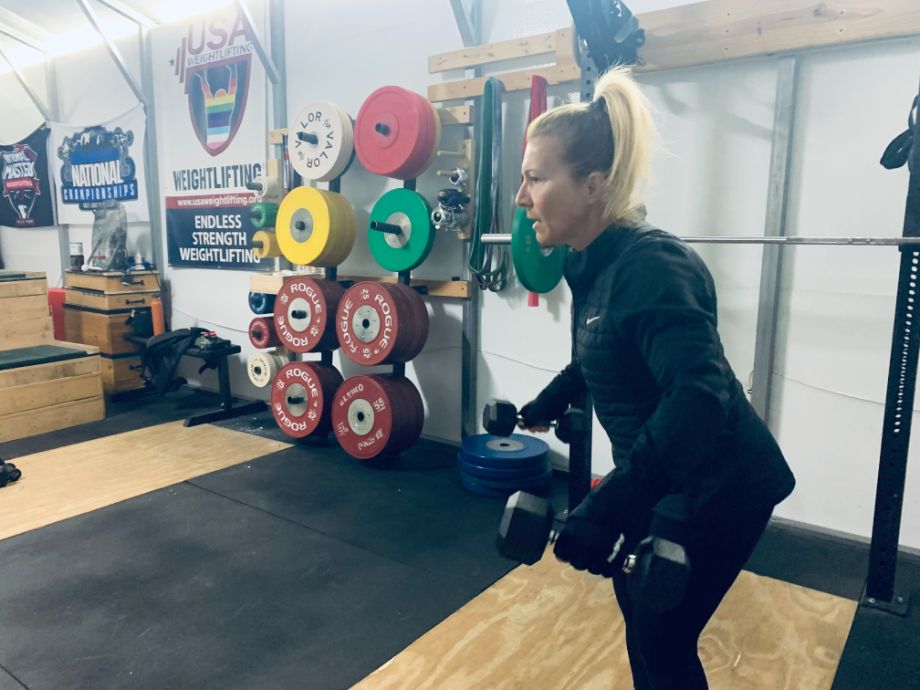
How many sets and reps to do will all come down to your personal goals:
- To build strength: Perform 2-6 sets of 1-5 reps using heavy dumbbells
- To build muscle: Perform 3-6 sets of 6-12 reps using moderate dumbbells
- To build endurance: Do 2-3 sets of 12-20 reps using light dumbbells
Regarding when to pencil in dumbbell rows, they work best on back days, back and biceps workout splits, arm workouts, or full-body workouts.
Common Dumbbell Row Mistakes
Practice makes perfect, but you’ll never have perfect form if you’re practicing poor habits. Here are a few of the most common mistakes to avoid while fine-tuning your form.
No Arching or Rounding
Dumbbell rows are for building your back, not obliterating it. That’s why maintaining a flat back and neutral spine alignment is paramount.
“You may have a slight natural arch in the back, and that’s okay,” says Caine Wilkes, OLY, USAW-L1, “but avoid overarching, as this puts added stress on the spine. Rounding the back is also a big no-no, as rounding the shoulders forward could contribute to or cause an injury to the neck or spine.”
Don’t Use Momentum
Getting a solid pump is about maximizing your muscle’s time under tension (TUT). That means getting a good, strong pull in the concentric pulling phase of the exercise and slowly guiding the weights back down during the eccentric portion.
RELATED: Eccentric Training
You really don’t want to let gravity take over during that eccentric phase, as recent studies published in the European Journal of Applied Physiology5 show that you may generate greater gains from eccentric contractions when compared to concentric contractions.
Dumbbell Row Variations and Alternatives
You’ll get plenty of mileage out of the dumbbell row, but it’s always nice to have a few variations and alternatives to sub in as the need arises. Here’s a few of our top picks.
Chest-Supported Dumbbell Row
Why do it: Maintaining the rigid posture required for standing dumbbell rows takes trunk and core stability to another level. Lying prone on an incline bench, on the other hand, makes the movement a touch easier while enabling you to really isolate those back muscles.
How to do it:
- Set a weight bench between 20 and 40 degrees of incline, select your dumbbells, and lie prone with your chest against the backpad.
- Row the dumbbells into your body, leading with the elbows.
- Squeeze the contraction at the top, then slowly lower the weights back down.
- Repeat for repetitions.
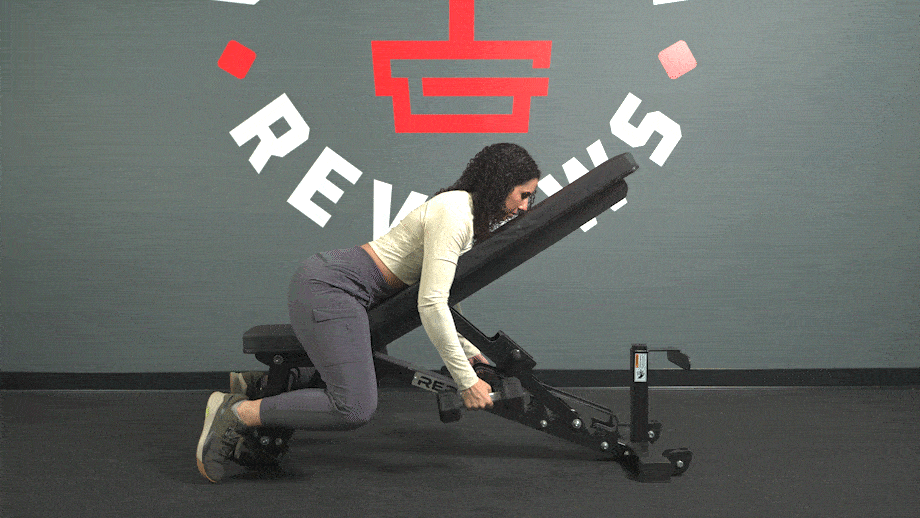
One-Arm Dumbbell Row
Why do it: “The classic single-arm dumbbell row lets you give all of your focus to one arm at a time to ensure you’re giving 100% on each rep,” says Caine Wilkes, OLY, USAW-L1. “It’s also great for correcting muscle imbalances and bilateral strength deficits.”
How to do it:
- Stand with a weight bench on your right and a dumbbell in your left hand. Place your right knee and right hand on the bench, bringing your torso forward and down until it’s parallel with the floor. Your left arm should be outstretched.
- Pull the dumbbell into your body, squeezing your lats at the top.
- Slowly lower the dumbbell back down.
- Repeat as needed, then switch sides and repeat the set.
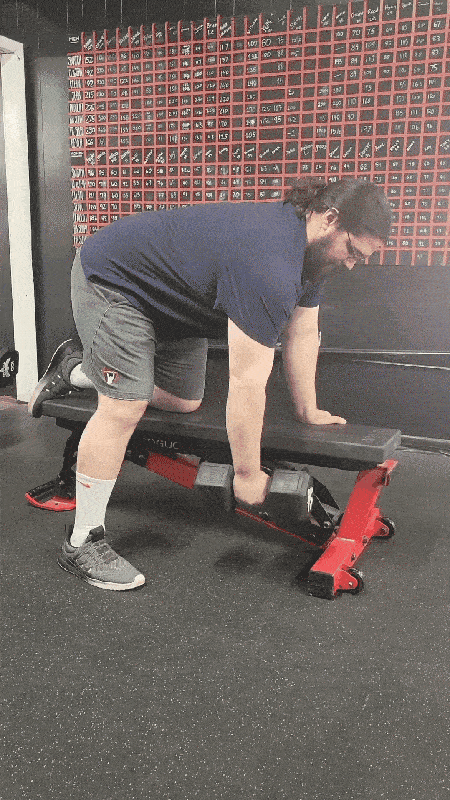
Bent-Over Barbell Row
Why do it: Dumbbells may offer plenty of upside over barbells, specifically in the recruitment of stabilizing muscles and increased range of motion; however, barbells make up for that by letting you really ramp up how much weight you’re lifting, allowing you to test your limits.
How to do it:
- Load your barbell to the desired weight and place it on the floor.
- Standing with your feet shoulder-width apart, hinge forward and bend your knees to reach down and grip the bar using an overhand grip.
- Extend your knees, bringing the bar to the midpoint between your waist and knees. Keep your torso angled at approximately 45-degrees.
- Retract your scapulae (shoulder blades), brace your core, and pull the bar into your sternum using your lats.
- Squeeze the contraction, then slowly bring the bar back down to the starting position.
- Repeat for reps.
RELATED: Best Bent-Over Row Alternatives
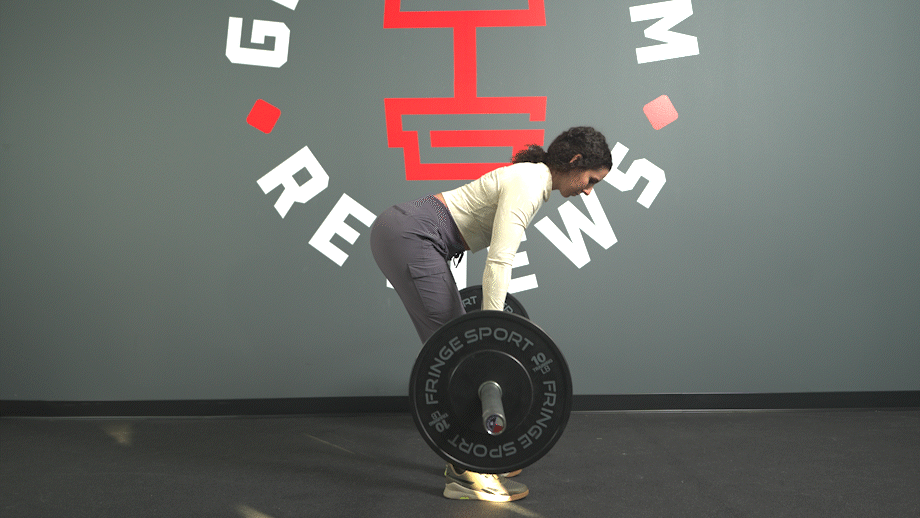
Meadows Row
Why do it: Named after renowned bodybuilding coach John Meadows, this unilateral movement allows you to focus on one side of the back at a time using the underutilized and highly-effective landmine attachment.
How to do it:
- Secure your barbell into the landmine base.
- Stand with the bar to your side and grip the end of the sleeve.
- Hinge forward, as you would for other dumbbell row variations, and row the bar into the body using your back muscles.
- Squeeze the contraction, then slowly lower it back down.
- Repeat for reps.
RELATED: Best Landmine Exercises
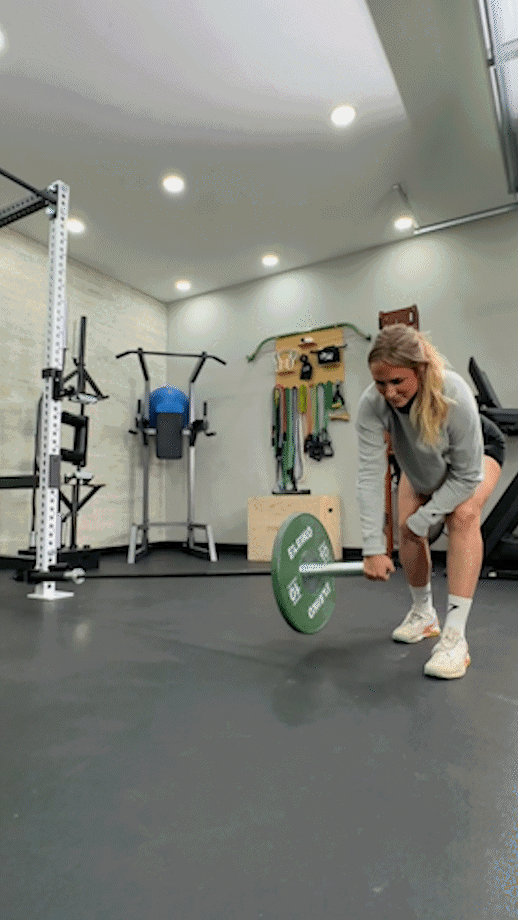
Seal Row
Why do it: The chest-supported dumbbell row gives you a leg up (figuratively speaking), but the seal row gives you a literal leg up by positioning you prone on a weight bench. Taking your legs totally out of the equation lets you isolate the back better than virtually all other dumbbell row variations (which is why we included it on our list of the best exercises for upper back).
How to do it:
- Lie prone (face down) on a weight bench holding a barbell or two dumbbells below you.
- Row the weights into your body until your elbows form 90-degree angles.
- Pause, squeeze your back muscles, then slowly bring the weights back down.
- Repeat for reps.
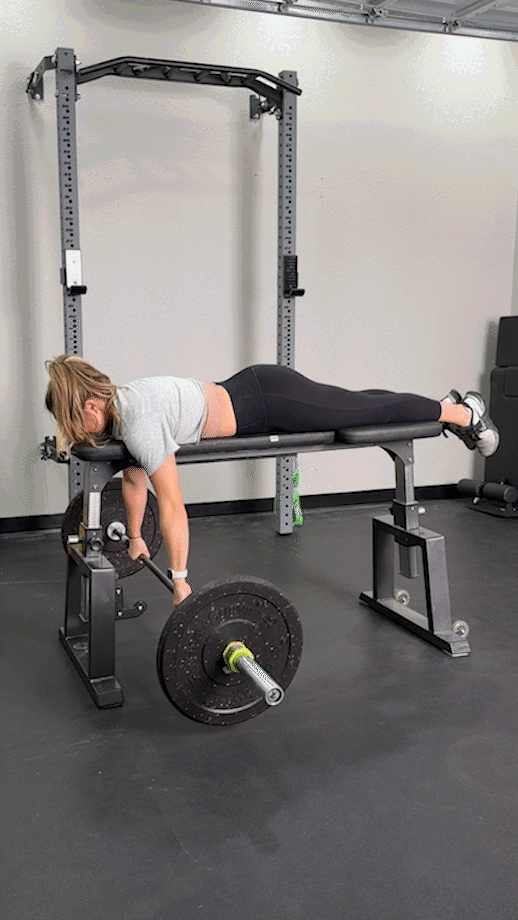
RELATED: Bench Workouts
Bent-Over Dumbbell Row: FAQs
What muscles do dumbbell rows work?
The dumbbell row works muscles throughout your back, including the latissimus dorsi, trapezius, and rhomboids, as well as the posterior deltoids in the shoulders, the biceps brachii, lower body muscles like your glutes and hamstrings, and core muscles like the rectus abdominis, transverse abdominis, and obliques.
RELATED: Guide To Compound Exercises
How to perform a dumbbell row?
To perform a dumbbell row, you’ll want to start upright with your feet shoulder-width apart and holding a dumbbell in each hand with your palms facing each other.
Then, you’ll lean forward by hinging at your hips until your torso forms a 45-degree angle with the floor as you pull the dumbbells up and into the sides of your body until your elbows are 90 degrees.
At the top of the movement, pinch your shoulder blades together and squeeze your back muscles, then slowly guide the dumbbells back down to where you started.
How heavy should you go on dumbbell rows?
If you’re unsure of the amount of weight you should be rowing, it’s best to start lighter and work your way up.
“Regardless of what your personal goals are, you should aim for a weight you can comfortably move throughout the set until you reach your last few reps,” says Caine Wilkes, OLY, USAW-L1, and GGR senior staff writer. “Those last few reps should be hard-earned if you want to reap the most reward from your hard work.”
You can also reference our programming suggestions for different fitness goals:
– To build strength: Perform 2-6 sets of 1-5 reps using heavy dumbbells
– To build muscle: Perform 3-6 sets of 6-12 reps using moderate dumbbells
– To build endurance: Do 2-3 sets of 12-20 reps using light dumbbells
Consulting an in-person or online personal trainer is another excellent option for training questions.
Are dumbbell rows worth it?
In our expert opinion, dumbbell rows are very worth it because they’re accessible for all fitness levels and allow you to progressively load your weight to build strength and muscle. Further, they can help you directly target your back muscles, improve your grip strength, and correct muscular imbalances. Another plus is that you really only need a pair of dumbbells and a small space to perform these.
What are dumbbell rows best for?
Dumbbell rows are best for targeting the muscles in your back with minimal equipment. There are also many row variations you can do to keep your back workouts fresh.
References
- Michaud F, Pérez Soto M, Lugrís U, Cuadrado J. Lower Back Injury Prevention and Sensitization of Hip Hinge with Neutral Spine Using Wearable Sensors during Lifting Exercises. Sensors (Basel). 2021;21(16):5487. Published 2021 Aug 14. doi:10.3390/s21165487
- Calatayud J, Vinstrup J, Jakobsen MD, et al. Importance of mind-muscle connection during progressive resistance training. Eur J Appl Physiol. 2016;116(3):527-533. doi:10.1007/s00421-015-3305-7
- Saeterbakken A, Andersen V, Brudeseth A, Lund H, Fimland MS. The Effect of Performing Bi- and Unilateral Row Exercises on Core Muscle Activation. Int J Sports Med. 2015;36(11):900-905. doi:10.1055/s-0034-1398646
- Gentil P, Oliveira E, de Araújo Rocha Júnior V, do Carmo J, Bottaro M. Effects of exercise order on upper-body muscle activation and exercise performance. J Strength Cond Res. 2007;21(4):1082-1086. doi:10.1519/R-21216.1
- Sato S, Yoshida R, Murakoshi F, et al. Comparison between concentric-only, eccentric-only, and concentric-eccentric resistance training of the elbow flexors for their effects on muscle strength and hypertrophy. Eur J Appl Physiol. 2022;122(12):2607-2614. doi:10.1007/s00421-022-05035-w




